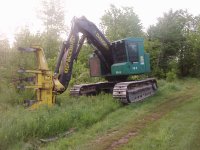EVERYTHING humans do have inherent risks. Hunting, fishing, driving, walking, gardening, land clearing, felling trees, burning brush, firewood processing, tractoring, equipment repair, mowing the lawn, etc. etc.
Assessing the risk and minimizing the possible damage is the difficult part.
This project can be done with a dozer, excavator, pick axe and shovel, team of horses/oxen, etc. Where to invest time and money is the question.
Call out a couple of excavation contractors and get a couple estimates on what you want done. What are the total equipment rental rates + damage waiver + liability insurance + delivery + fuel (homeowners typically get 8 hours/day, 40 hours/week period. one hour over = extra day)+ learning curve + risk.
No clue what the average rate is in your area, but locally runs $4-4500 per acre (43000 sq.ft.) and will be done.

